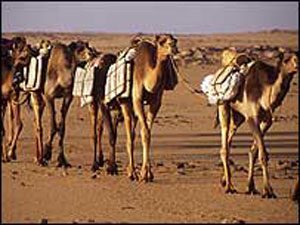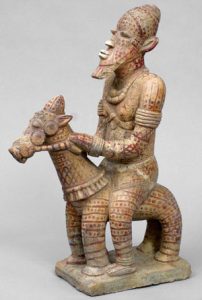
Medieval African economy: A salt caravan across the Sahara Desert
West African caravan trade
The African economy had always involved international trade. But trade became even more important in the Middle Ages. Starting around 1000 AD, West African traders also sold gold. Traders with camels carried the gold across the Sahara from West Africa to North Africa. North African traders sold horses and salt from Saharan salt mines to West Africa. They bought West African people.
Medieval Islamic Economy
Early African economy
All our early Africa articles
These traders enslaved their prisoners (mainly women) and forced them to walk across the Sahara Desert to North Africa. From there traders shipped the gold to Europe and to West Asia. Most of the women stayed in North Africa. They became enslaved servants for rich people there. But by the 1300s West Africa was beginning to sell manufactured goods like locally made cotton cloth as well as raw materials like gold.

A West African man on a horse (Djenne, ca. 1300 AD)
East African trade with India and Iran
From Central Africa, starting about the same time, traders sailed gold and furs and ivory down the rivers to the East African coast. They mined iron ore and smelted it. Because good hardwood trees grew in Central Africa, people living along the Congo River were able to smelt iron ore at high temperatures. They got high quality iron and sold it to steel-makers in India.
History of steel
So along the coast, East Africans sold the iron and other things to West Asian and Indian traders in exchange for glass beads and fancy silk and cotton cloth. By the 1400s AD, East African traders were also beginning to sell coffee to Sufi people in Yemen, in the Arabian Peninsula, and as far east as India.
African sailing ships left Mombasa and Malindi for the Persian Gulf and India, selling ivory, slaves, coffee and gold, and buying cotton cloth, cowrie shells, and glass beads. Within Central Africa, people were probably trading dried fish, copper, and other things from region to region, and using small copper crosses, cowrie shells, copper bracelets, and Indian glass beads as money.

Copper crosses used as money in Congo
North African manufacturing and trade
Islamic North Africa traded across the Mediterranean Sea to Europe, and to West Asia, and from there all along the Silk Road to China. In Egypt, big factories produced linen cloth, paper, and glass to sell. Egypt imported natron, a kind of salt, from Lake Chad to use in glass-making. Knitting, invented about 400 AD, was exciting and new, along with embroidered linen and wool.
History of knitting
Where is paper from?
Glass and glass-blowing

Egyptian knitted sock (ca. 1000 AD)
Farming and fishing
But, just the same as in Europe and Asia, the most important parts of the ancient African economy were farming and fishing and hunting and gathering and taking care of animals. There weren’t really very many traders, or salt miners, or gold miners. Most people in West Africa and East Africa and Kush and Meroe and Central Africa were farmers.
In South Africa, a lot of people were shepherds and cattle herders, and in the Kalahari Desert, where the environment was not right for farming, the San remained hunters and gatherers, like the forest people deep in the Central African rain forest.
Learn by Doing – African Economy
More about the trade in cotton cloth
More about the later slave trade
Bibliography and further reading about the medieval African economy: